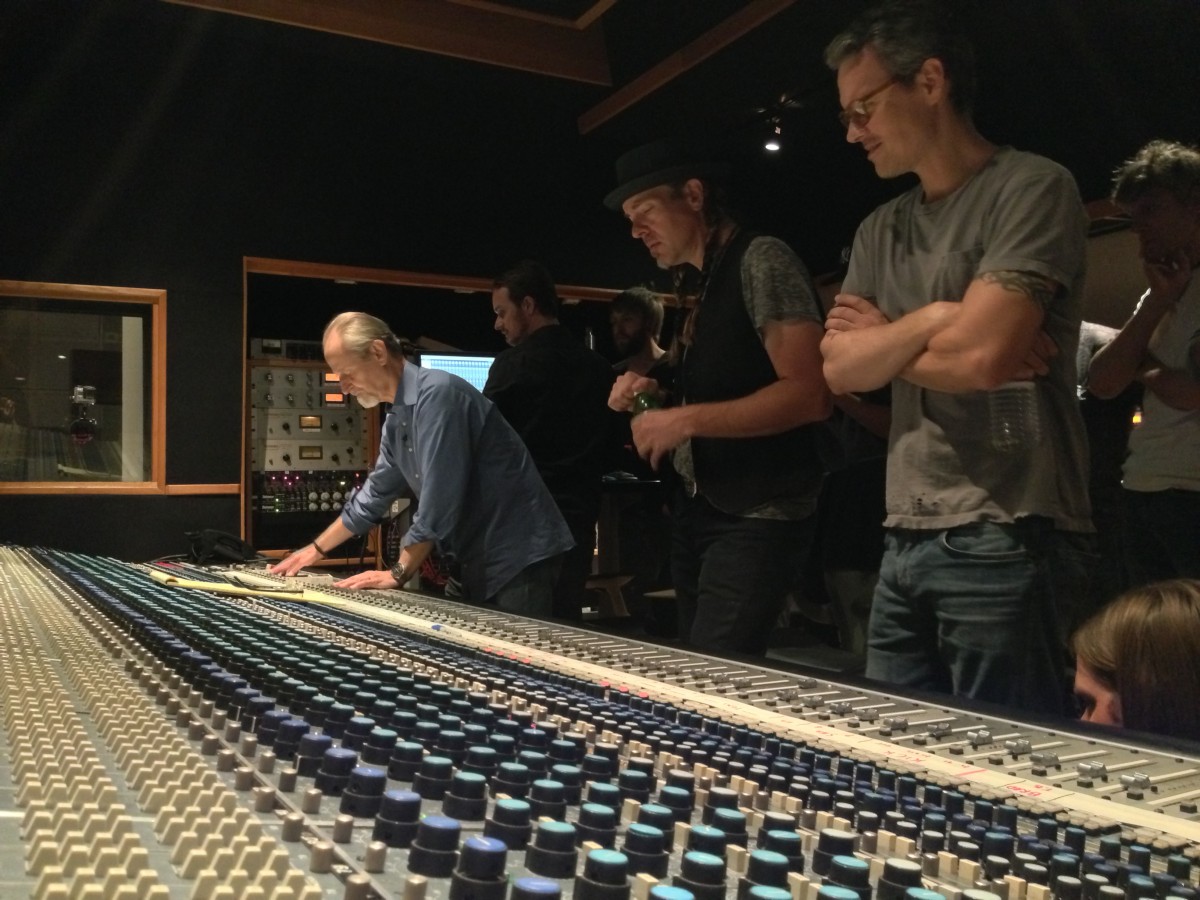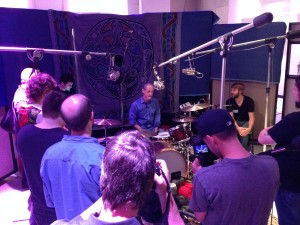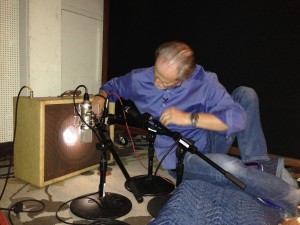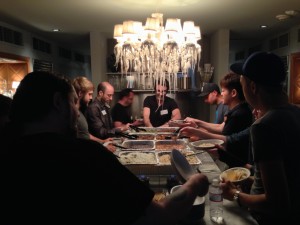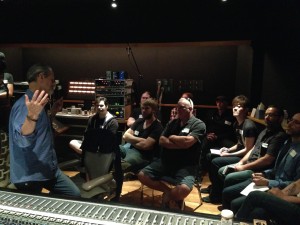The Eddie Kramer Experience begins at EastWest Studios, Hollywood, CA with a sense of history. Considering its heritage, EastWest Studios was the perfect venue for a Studio Prodigy Master Class of this caliber. The place is steeped in recording history, owing to its days as United Western Recording, Ocean Way and Cello Recording Studios, and home to many great records from such artist as Frank Sinatra, The Beach Boys, The Mamas and the Papas and more.
In recent years, music giants such as the Red Hot Chili Peppers, Paul McCartney,andThe Rolling Stones have burnt their sounds into the walls of 6000 Sunset Boulevard. Now, producer and engineer Eddie Kramer was set to share his experience and knowledge with Studio Prodigy Master Class Series’ eager pupils.
Eddie Kramer is clearly an industry legend. With a discography boasting such rock icons as Jimi Hendrix, Led Zeppelin, The Rolling Stones, and Kiss, you know you’re in for a once in a lifetime treat. While the studio was waking up for another creative day and as students trickled into the lobby, you couldn’t help but notice a collective buzz. Word quickly got around that Eddie arrived and was in Studio One, our home for two days.
The goal was to track a song from start to finish, and mix it for mastering the following weekend up the street at Bernie Grundman Mastering during Studio Prodigy’s Session Five- ‘Analog Mastering in a Digital World’. The band for the session was Abandon Jalopy featuring Brad Smith (Blind Melon), Dave Krusen (Pearl Jam), Ash Sutton, and Kevin Haaland.
When you work with Eddie Kramer, you quickly understand who’s in charge. He’s full of energy, knows what he wants and moves quickly to achieve it; he’s got a wicked sense of humor too!
Considering the amount of ground the session had to cover, mics had been setup the day prior. However, Eddie spent considerable time with the class at each station reviewing and answering questions regarding the selection, positioning, and interaction of microphones, as well as the choice of instruments and amplifiers for the session.
The first stop was the drum kit, and the plethora of microphones present. Eddie had his trademark setup in place, and some of his tricks were revealed; heavily weighted kick drum anyone? Eddie’s experience from hundreds of premiere sessions was on display as he shared not only the reason why he uses X gear on Y instrument, but how he arrived at the destination.
The crew, eager to learn, followed our speaker as he moved on to guitar and bass setups. What followed was a hands-on experience, as class members crawled in to the doghouses to adjust amp mics with Eddie. A three-way mic arrangement that included Royer Labs R-121 ribbon mics and the ubiquitous Shure SM-57 were set up, acting as a sort of reverse crossover network. This plus a large diaphragm tube mic provided the basis for the wonderful guitar tones heard throughout the next 48 hours.
Bass meanwhile was a classic straightforward affair, featuring a direct box and a Neumann FET47, staring down the cone of an Ampeg bass amp combo comfortably situated in the closet; so rock n’ roll!
After the station tour (Vocals to come later), it was time to get sounds. The group headed into the control room where Eddie manned one of, if not the world’s largest Neve 8078 consoles. Dave Krusen was summoned to man his drum kit, and within a few minutes and bringing up only four of the insane assortment of microphones assembled, jaws were left on the floor. The shock on everyone’s ears coupled with a grin from Eddie was noticeable.
Most people work for hours, and days, and still don’t arrive at what was being heard. This was using only a handful of microphones and it sounded like a record! Eddie however had grander plans and gradually all the mics were brought into play to form a drum sound most never knew possible, and others dream of. Our leader gave a highly detailed account of the processing, eq, compression, and balance before moving on (as he did throughout the session). How often does someone get to say they sat at the console with Jimi Hendrix’s producer and engineer for a hands- on tutorial?
Next, the session proceeded to the guitar and bass tones with Eddie poaching members of the class for help in manipulating mics along the way. The sounds were set and we were ready to begin laying down the track at hand.
The rich sounds being picked up were fed to a Studer 2” machine before being funneled through a behemoth array of Burl Mothership converters and off into the DAW. In true hybrid fashion, all tracks were played back from the DAW out through the Burl converters, and to the Neve console for further processing and mixing down to ½” tape. Well on our way into tracking, with day one’s lunch seemingly a memory from another lifetime, it was time for dinner.
Studio Prodigy Master Class events are as much about the camaraderie of a group of people with a shared passion for making records as they are about getting schooled in the art of record production. As the class broke bread with a living legend, you could hear pockets of conversation filled with experiences from industry markets as diverse as those who came for the event; Europe, Asia, South America, and North America. Along the way, producer/engineer Billy Bush who was working out of EastWest Studio Two for a couple weeks, popped in for some conversation with Studio Prodigy founder, producer and engineer Ryan Hewitt. As dinner continued well past any food left on the table, it was time to dive back into creativity and Eddie made it known.
Tracking continued well into the evening in an effort to hold day two for vocal overdubs and mixing.
Day two started with bagels and conversation – everyone was well rested and ready for more, lots more.
If you were taking a break from overdubs and not hanging in the lobby or kitchen, you most likely were in studio one’s lounge. The room was full of all kinds of conversation, the World Cup on the flat screen and strange, but tasty candy from New Zealand (by way of Ryan Hewitt). Band members and attendees alike shared the space as a refuge of sorts. Brad Smith sat chomping at the bit, while waiting for the call; are they ready for vocals? Former Studio Prodigy speaker/ engineer Ross Hogarth dropped by at one point and hung out for bit.
Tracking continued deep into the evening, and with dinner in the rearview mirror, it was finally time to mix with the master, Eddie Kramer. While mixing would run through the night and into the early morning hours, one of the greatest moments was enjoying Eddie sharing unseen candid photos he had taken during sessions with Jimi Hendrix. Listening to Eddie re-live every moment- “Notice Jimi’s expression in this shot during a take, and his eyebrows moving upward in the next, now look at Mitch Mitchell’s face in response in this one.” It’s moments like this that you take with you.
With the mix perfected and printed to tape, the session wrapped. Everyone left with more studio knowledge and stories than they’d bargained for, and new friends to boot!
Did we mention some of our session sponsors gave away some amazing prizes? Stay tuned to learn who won and what they walked away with.
To learn about upcoming Studio Prodigy events, join our newsletter (use the form on this page).
Studio Prodigy Master Class Series – Session Four was sponsored by: Vintage King Audio, Royer Labs, Mojave Audio, Shure, F Pedals, Waves, EastWest Studios, Recording Radio Film Connection, Gearslutz, and Delta H-deisgns

